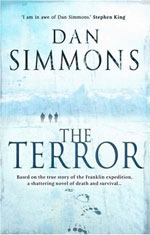 Dan Simmon’s latest novel was recommended to me by a friend. He piqued my interested by making it sound a bit like The Thing, but with an historical setting. In the end it took me several months to actually track down a copy at my local library, but the book proved worthy of the added anticipation.
Dan Simmon’s latest novel was recommended to me by a friend. He piqued my interested by making it sound a bit like The Thing, but with an historical setting. In the end it took me several months to actually track down a copy at my local library, but the book proved worthy of the added anticipation.
I’ve not read any of Simmons’ previous works, so I had little in the way of expectations – other than the vague idea that, with its Thing-like subject matter, it might be an enjoyable, but pulpy horror yarn. As it turns out The Terror is an absorbing historical thriller with a supernatural subplot expertly weaved throughout.
The first page initially deterred me, mainly due to Simmons’ fondness for epic length sentences that keep you waiting for that mental drawing of breath. Perhaps this is a cunning writer’s trick. Anyhow, by the second page I was fully immersed and all complaints over literary construction were quickly forgiven.
Based on what must have some exhaustive research (I believe, among other efforts, Simmons actually travelled to the Arctic) The Terror paints an astonishingly detailed portrait of life for the crew of HMS Terror and HMS Erebus, trapped in the Arctic as a result John Franklin’s ill-fated 1845 expedition to conquer the Northwest Passage. There are a number of historical novels that vividly describe life at sea, but Dan Simmons places the reader so close to his subject that you’ll want to wrap up warm before delving into The Terror.
Those familiar with the story of the Franklin Expedition will know that much remains unexplained, particularly the exact nature of the ultimate fate that befell the twin crews. Of course where facts remain oblique there’s ample room for conspiracy theorists and novelists to fill in the blanks. While there’s no doubt that much of The Terror should be viewed as fiction (as intended), there’s a solid framework of fact welded to a secondary tale of an unstoppable, terrifying beast that picks off the unfortunate sailors at regular intervals.
While far from essential, a little reading up on the Franklin Expedition makes The Terror all the more enjoyable. Certain facts, discoveries made after the event, and biographies of key characters are made an integral part of the fictional story – integrated so skilfully in fact that you’ll find yourself convinced that Simmons’ version of events is entirely plausible.
However, detailed historical research and elaborate plot construction clearly isn’t enough to keep Simmons off the streets as an impressive dose of Inuit folklore and mythology is also factored in. This plays a significant role towards later chapters of the novel, but is well enough integrated that the shift from deep history to supernatural horror to mysticism doesn’t jar.
Although The Terror, by virtue of its Arctic setting, is doomed to be forever compared to The Thing, it should be stressed that it is leagues away from being a clone of that other great icebound chiller. It is a stunning novel that might deter casual readers simply due to its depth and wealth of detail, but will forever reward those bold enough to embark on this rendition of the Franklin Expedition.
Just remember: it’s not called The Terror for nothing.
